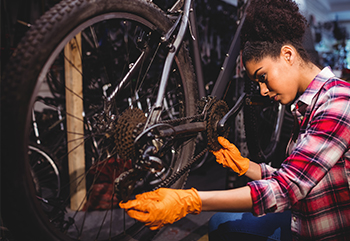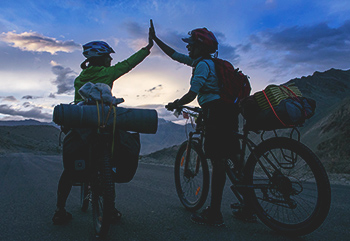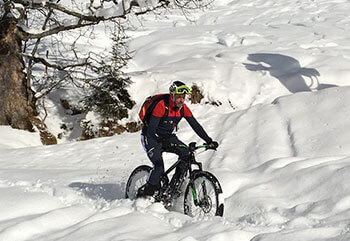How to Enjoy Cycling in the Monsoon: Tips and Tricks

Cycling during the monsoon can be both exhilarating and challenging. The refreshing rain, lush green landscapes, and the cool breeze can make for a delightful ride. However, the wet roads and unpredictable weather conditions require extra precautions. This guide aims to provide you with detailed tips and tricks to enjoy cycling in the monsoon safely and effectively.
How to Enjoy Cycling in the Monsoon
Preparing Your Bicycle for Monsoon Cycling
Waterproofing Your Bicycle
One of the first steps in preparing your bicycle for cycling in the rain is to ensure its waterproof. Protect your bicycle frame with a layer of protective wax to prevent rust. Pay extra attention to the chain, applying a wet lube designed for rainy conditions. Use waterproof accessories such as mudguards to keep the splashes at bay. For the best protection, consider high-quality bicycle frames made from materials like hi-tensile steel, carbon, and alloy. Our brand uses these high-quality materials, which are excellent for rainy seasons and provide durability and strength against harsh weather conditions.
Essential Monsoon Cycling Gear
Equipping yourself with the right gear is crucial for a comfortable ride in the rain. Invest in waterproof clothing, including a good-quality rain jacket and pants. Waterproof shoes and socks will keep your feet dry, while gloves will provide grip and warmth. A helmet with a visor can help shield your eyes from rain.
Choosing the Right Tires
Tires play a vital role in ensuring a safe ride on wet roads. Opt for tires with deeper tread patterns to provide better grip. Lower the tire pressure slightly for improved traction. Specialized monsoon tires with a compound that performs well in wet conditions can be a game-changer.
All bicycles come with different types of tires based on your needs and preferences. For example, hybrid bicycles have thin tires, FTBs (Fat Tire Bikes) have fat tires, and mountain bicycles have thick tires. It's all about choosing the right type of tire that suits your riding style and conditions. If you're unsure about which type of tire suits your riding style, visit our website at www.outdoors91.com. Use the "Find Your Perfect Bicycle" filter on the homepage by entering your gender, height, and purpose of use. Our website will recommend bicycles that match your needs and preferences, including different types of tires for various riding styles.

Safety Measures for Monsoon Cycling
Visibility Enhancements
Staying visible in low-light, rainy conditions is essential for your safety. Wear reflective gear and bright-colored clothing to make yourself more noticeable. Equip your bicycle with front and rear lights, and consider adding side reflectors.
Handling Wet and Slippery Roads
Navigating wet roads requires careful handling. Use your brakes gently and progressively to avoid skidding. Take corners slowly and maintain an upright posture to keep balance. Reduce speed to ensure you have enough reaction time in slippery conditions.
Dealing with Heavy Rain
If you find yourself caught in a heavy downpour, look for shelter and wait for the rain to subside. If you must continue riding, reduce your speed and stay alert for obstacles. Ensure your lights are on, and avoid riding through deep puddles as they may conceal hazards.
Health Precautions During Monsoon Cycling
Staying Dry and Comfortable
Layer your clothing to stay warm and dry. Moisture-wicking base layers can help keep sweat away from your skin, while an outer waterproof layer will protect you from rain. Dry off promptly after your ride to prevent chills and chafing.
Preventing Waterborne Diseases
Monsoon season often brings an increase in waterborne diseases. Drink only clean, filtered water and avoid splashing through puddles which can be contaminated. Maintain good hygiene by washing your hands and face after the ride.
Boosting Immunity
Your immune system needs extra support during the monsoon. Consume a balanced diet rich in vitamins and minerals, stay hydrated, and consider supplements to boost your immunity. Regular cycling also helps keep your body resilient.

Maintaining Your Bicycle Post-Ride
Cleaning and Drying Your Bicycle
After a wet ride, rinse off any mud and dirt from your bicycle. Dry it thoroughly using a clean cloth to prevent rust. Pay special attention to the chain, brakes, and gears, lubricating them as necessary to maintain smooth operation.
Inspecting for Damage
Inspecting for Damage
Regular inspections are crucial for maintaining your bicycle and preventing small issues from becoming big problems. It's important to check your bicycle for rust spots, especially on the chain and gears, as these can affect performance and longevity. Inspect your tires for cuts or embedded debris, which could lead to punctures or unsafe riding conditions. Ensure your brakes are functioning correctly to maintain control and safety while riding. By performing these checks regularly, you can ensure your bicycle stays in good condition and enjoy safer and more reliable rides.
Planning Your Monsoon Rides
Choosing the Right Routes
Select routes that are less likely to be waterlogged and have good drainage. Avoid trails that are known for flooding or have a lot of loose gravel. Scenic routes through parks or along rivers can provide a pleasant riding experience.
Timing Your Rides
Monitor the weather forecast and plan your rides during periods of lighter rain. Early mornings or late afternoons often have more stable weather. Avoid peak rain hours to minimize the risk of getting caught in a heavy downpour.
Enjoying the Monsoon Experience
Embracing the Beauty of Nature
Monsoon transforms the landscape into a vibrant, green wonderland. Enjoy the scenic beauty, take in the fresh air, and observe the rejuvenated wildlife. Carry a camera to capture the stunning sights along your route.
Riding with Friends and Groups
Cycling with friends or in groups can make your rides more enjoyable and safer. Follow group riding etiquette, maintain a safe distance, and look out for each other. Group rides can also introduce you to new routes and experiences.
Participating in Monsoon Cycling Events
Look for local cycling events organized during the monsoon. These can be fun and provide a sense of community. Competitive rides and charity events are great opportunities to challenge yourself and meet fellow cyclists. For most cycling events, the best app to use is the Wynd.fit app. This app creates cycling challenges and events throughout the year. If you complete their events under specific conditions, you can win huge prizes. Wynd.fit is excellent for tracking, recording, and sharing your cycling, walking, running, and stepping activities. It helps you improve your stamina, enhance your riding skills, and maintain a healthy lifestyle.

Frequently Asked Questions (FAQs)
Is it safe to cycle in the monsoon?
Yes, it is safe to cycle in the monsoon if you take proper precautions, use the right gear, and follow safety guidelines.
What should I wear for monsoon cycling?
Wear waterproof clothing, including a rain jacket, pants, waterproof shoes, and gloves. Bright and reflective gear will enhance your visibility.
How do I maintain my bicycle in rainy conditions?
Regularly clean and dry your bicycle after rides, use wet lube for the chain, and inspect for any rust or damage.
How can I stay visible during monsoon rides?
Wear bright, reflective clothing and equip your bicycle with front and rear lights. Reflective tape on your bicycle can also enhance visibility.
What should I do if caught in heavy rain?
Seek shelter if possible. If you must continue riding, reduce your speed, use lights, and avoid deep puddles.
Related Blogs

Electric Bicycle
5 Maintenance Tips of Electric Bicycle | InfographicBicycle maintenance is most important for longevity. So, here are few tips that will help you to maintain your electric bicycle for a long time.

Mountain Bikes
8 Easy Tips for an MTB NewbieA few tips that you can use to make your MTB learning days an incredible experience

Mountain Bikes
Eight Tips To Ace Mountain BikingA mountain biking trip, while exciting can often be dangerous too. Read through these eight important and practical tips to ace the adventure.

